Traditional Chinese Crafts
Crafts are a big part of traditional Chinese culture and art. Throughout the far-reaching history of China, crafts used to be the daily life necessities in the past, but gradually they become precious art works, intangible heritages and even the symbols of China. Following items are the most popular traditional Chinese crafts worth taking home.
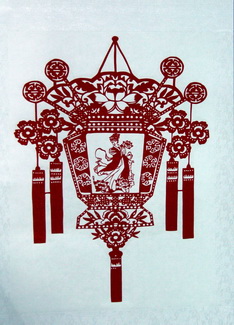
Paper-cutting is one of the most representative types of traditional Chinese art. With thousands of years' history, Chinese paper-cuts has been a popular folk art since paper was invented by Cai Lun in Western Han Dynasty (206 B.C. - 24 A.D). This folk craft is usually done with red paper, scissors and engraving knives, and the inspiration for paper-cuts most comes from the themes in daily life such as flowers, birds, Chinese zodiac animals and some famous Chinese historical figures. Paper cuttings are still greatly applied in Chinese Spring Festival celebrations and weddings for blessedness, luck and fortune by pasting them on the doors and windows.
For many foreigners, red lanterns is the most easily recognized element of Chinese architecture. Chinese people associate the round-shaped stuff with reunion, and color of red with joy and good fortune. Thus red lanterns are hang outside the doorway of houses in China not only as a sources of light or decoration, but a way of sharing the joy of marriages and newborns as well as new year celebrations. Traditional lanterns are made up of a metal or bamboo frames and a cover of red gauze, while modern lanterns are more exquisite and complex in sizes, shapes, colors and images. Particular in Chinese Lantern Festival, you would enjoy a feast of lantern shows in historical Xian.
China boasts the earliest umbrella-making history in the world. As a daily necessity of rain gear in ancient times, oil paper umbrella was made out of natural materials including bamboo strips and lint paper coated with natural waterproof tung oil.
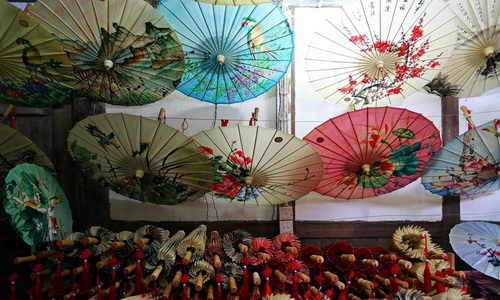
Originating from China, the craftsmanship of oil paper umbrellas were brought to the whole Asian and south Asian countries such as North Korea, Vietnam, Thailand, Japan, etc and developed with their local characteristics. Nowadays, oil paper umbrellas are still prevalent in many southern cities like Hangzhou and Suzhou, and most of them are sold to tourists as works of art or applied for an artistic use.
Embroidery is arguably Chinese most sophisticated craft with a far-reaching history dating back to Neolithic age. China is the oldest silk kingdom and nearly 90% of Chinese embroideries are made on silk that are later made into clothes, scarves, purses, shoes, banners, screens, etc. Women in ancient China did not go out for a job, but stayed home for embroidery work at leisure time. Refined by generations, traditional embroidery becomes the most exquisite and elegant art varied in different styles and regions. There are four best-know styles in China, namely Su Xiu (Jiangsu Embroidery), Xiang Xiu (Hunan Embroidery), Yue Xiu (Cantonese Embroidery) and Shu Xiu (Sichuan Embroidery).
The most popular Chinese gifts received by foreigners, I guess, are hand-made fans. Fans in China is no longer a tool to dispel the summer heat, but an outstanding part of traditional culture and art for thousands years. In ancient times, both men and women would use fans as an artistic symbol of literati tastes and social status.
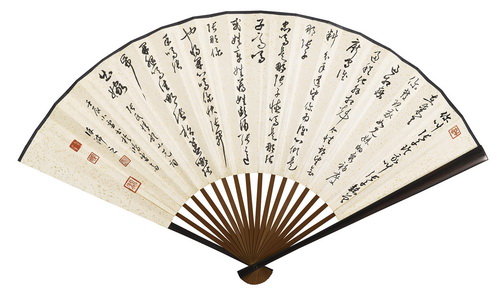
Some fans are made of paper with calligraphy or classic landscape paintings, while some uses silk as the face with meticulous embroidery designs. Varied by materials and shapes, Chinese fans can be divided into complex categories, such as folding paper fans, feather fans, silk fans and palm-leaf fans.
Kite is one of the classic intangible cultural heritages of China, and in many touristy souvenir shops you could easily find kites in various colors and images, such as butterfly, dragonfly, eagle, panda, dragon, swallow, goldfish and etc.
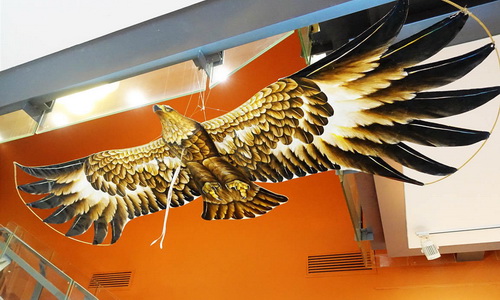
China, the birthplace of kites, has a profound kite-making history that could be dated back to Warring States Period (475 - 221 B.C.) when kites were invented as a tool for communication and detection in wars. Nowadays, Weifang City of Shandong Province is crowned as the World's Capital of Kites by housing the largest kite museum with dazzling kite exhibitions and hosting an annual international kite festival. Flying a kite has been a common practice for people all over the country. In spring, you are most likely to see families flying kites in open parks at weekends.
Tie-dyeing is a traditional textile dyeing art that could be mostly found in the Southwest China. Tie-dyeing techniques were invented in 3rd to 4th century in China, and they are still employed by ethnic minorities in Yunnan and Guizhou Province.
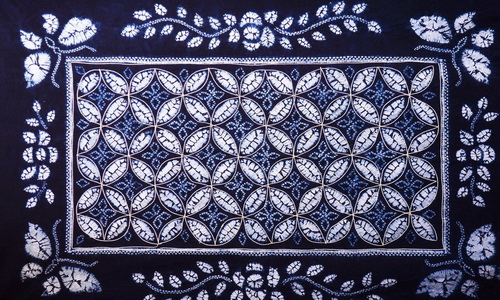
Zhoucheng Village in Dali is the best-known place for fine craft of tie-dyeing. More than 5,000 Bai people seek a living in the tie-dyeing business, and their craft works are blessed with the highest quality among all other regions. The dyes are uniquely extracted from the indigo plants, and the patterns are made by knots, sticks and threads. Thus, most tie-dyeing pieces have a blue and white color mix as well as multifarious images.
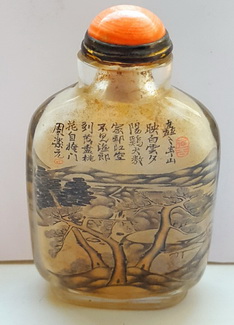
Snuff bottles were used as containers for powdered tobacco by ancient Chinese and Mongolian nobilities, and bottle also mirrors the owner's social status. Nowadays, snuff bottle is more of an exquisite traditional craft work that you could find nearly in every souvenir shop of Beijing. Made of crystal, glass or agate, the snuff bottles are greatly decorated with calligraphy works and landscape paintings. The most remarkable ones even have the paintings done on the internal face by an extremely narrow and sharp brush. Searching for a snuff bottle, you are suggested to hang out at the Skewed Tobacco Pouch Street (Yandaixie Street) in Beijing.
The dough figure is a skilled Chinese folk artwork made out of colored flour dough. Usually, dough figures are made on streets and sold on the spot. The craftsmen (most are seniors) are able to use a bamboo knife to knead popular roles in traditional Chinese history, myths, legends, and dramas like Sun Wukong and Guanyu. Those figures are bright in colors and vivid in expressions with teeth and fingers. Though they are pocket sized, you could see them complete with clothes, shoes and even weapons like sword in hands. You are most likely to find a dough figure vendor at a commercial street or at the entrance of a tourist area.
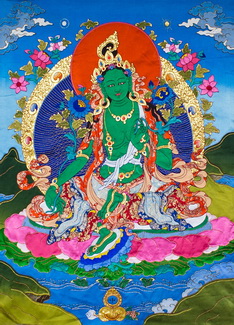
As one of the most important articles in Tibet, Thangka refers to a painted or embroidered Buddhist scroll painting hung in a monastery or a family altar. Generally, the themes of Thangkas include portraits of Buddha, stories from the lives of saints and brilliant Tibetan Buddhism masters. A Thangka work may take months or even years to finish which depends on the size. During the Shoton Festival, you could see the largest and best Thangka painting revealed on the hill slope near the Drepung Monastery. The unique making techniques make the colors of Thangka stay flamingly clear for hundreds of years, and thus why they are obsessed by worldwide collectors.
An in-depth China trip not only allows you to fancy about bewildering folk crafts, but also to involve in some easy and fun hands-on activities. If traveling with Elysian Tour, you are blessed with rare chances for following crafts experiences in China.
- Attend a Chinese Calligraphy Class
- Draw a Facial Mask of Peking Opera
- Make Tiger-Head Shoes at a Cave Dwelling
- Make a Miniature of Terracotta Warrior
- Visit Hangzhou Arts and Crafts Museum
- Visit a Tie-Dye Workshop at Zhoucheng
- Join in the Lantern Show of Xian
Calligraphy is the most symbolic art form of China. With us, you will dive into an archaic traditional courtyard hidden in the back alleys of Beijing, and visit a famous calligraphy master to pick up a calligraphy class. Firstly, you will be briefed on the Four Treasures of the Study for writing, including brushes, ink, paper, and ink-grinders, which are totally different the pens used nowadays. And then learn some basic strokes and characters in different styles. The calligraphy work done by yourself could be taken away if you want to keep it.
Still in a quaint traditional courtyard of Beijing hutong, you could also become a brilliant painter with the guide of a local artist. The colorful facial mask is a big element in Peking Opera for audience to distinguish the characteristics of the roles. For example, red stands for loyalty, blue for integrity, yellow for rage and white for duplicity. You have a chance to learn to paint one on your own, and the finished masks could be brought home as souvenirs. If you travel with children, never should you skip it.
Tiger-head shoes is one of the classic traditional crafts of China. In northern part of China, grandmas like to make the shoes for their grandchildren (usually for infant babies or toddlers) as a way of giving good luck. The shoes are highlighted by their tiger heads made with yellow, black and red threads to draw the outline. Different embroidery skills are applied to make the tiger full of vigor and spirit. At an old cave dwelling near the Terracotta Army, you will drop by a local family and learn to make the tiger-head shoes from a granny. You do not need to undertake from the beginning to an end, but instead cover the very critical part like the eyes of the tiger.
Discovered by a well-drilling farmer in Xi'an, Shaanxi in 1974, the Terracotta Army is one of the biggest archaeological finds in 21st century. Dating from 210BC, more than 8,000 life-sized soldiers, 130 chariots with 520 horses, and a further 150 cavalry horses were excavated on the site to showcase the matchless empire power of Qin. The biggest wonder of the army could be found by their distinctive facial expressions and uniforms. After a sightseeing in the museum, you might visit a workshop to knead a terracotta warrior with the inspiration from the real ones, and that will inject much more fun to the tour especially for student travelers.
Nestled by the Grand Canal, Hangzhou Arts and Crafts Museum is an unusual public space where you cannot only see a good variety of folk arts and crafts, but also witness the artists and craftsmen masters to demonstrate their craft-making skills such as umbrella-making, fan-making, bamboo weaving, pottery work, silk-weaving, wood-carving, etc. Moreover, plenty of opportunities are given to participate in some as well. Paper fan is a popular local specialty of Hangzhou, and many travelers would choose to buy one as souvenir. There you could learn to make one at the master's studio and keep it for your own.
Tie-dyeing has a long history of more than 1500 years. Zhoucheng, a lovely small town not far from Dali, Yunnan, is famed as the hometown of tie-dyeing by having more than 5,000 women of Bai minority occupied in the tie-dye industry. Many families in Zhoucheng have their own small handmade tie-dye workshop. Walking along the lanes, you could peek through a doorway or window for quaint courtyards with a lot of blue and white tie dyed cloth pieces hanging up. Most workshops are available for a visit, and you are even offered chances to take a tie-dyeing class. Alternatively, you could select some Bai people's traditional tie-dye handcrafts like tapestry, table cloth, scarfs and handkerchiefs.
Lanterns is not only an ancient lighting facility, but more of artworks in modern China. Unlike the hexagonal palace lanterns in most traditional courtyards, lanterns for New Year celebration are diverse in colors, sizes and shapes. In Xian, during the Spring Festival, you could ascend the ancient City Wall or go to the Tang Paradise Park that are blazingly illuminated by lanterns of various shapes and colors themed with Chinese zodiac animals. Some communities may even organize lantern show parades to observe the Lantern Festival, and you are free to join in if coming across one.









